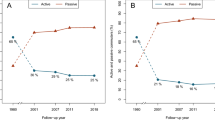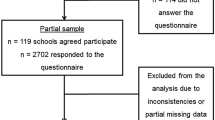Abstract
Background/objectives
Childhood obesity has increased enormously. Several lifestyle factors have been implicated, including decreased physical activity, partially involving a decline in active travel to school. We aimed to establish the association between school transport mode and physical activity levels of primary 6 and 7 children (aged 10–12). Secondary outcomes were body mass index standard deviation scores, blood pressure levels and lung function.
Subjects/methods
A cross-sectional study was conducted with a total number of 432 children from three primary schools in North East Scotland. Actigraph accelerometers were used to provide objective measures of physical activity. Ninety-two children in primary 6 and 90 children in primary 7 (40 in common) had adequate data. Modes of transport to school were assessed by a questionnaire. Two hundred and seventeen children in primary 6 and one hundred and sixty-five in primary 7 returned adequate questionnaires. Children who used active transport modes for >70% of their journeys to school over the week were coded as active travellers and <30% were coded as passive travellers. All children also had height, weight, blood pressure levels and lung function measured.
Results
Children who lived further away from school, and in more expensive properties were more likely to travel passively to school. Actively commuting children (70% walking) had significantly higher activity levels than passive commuters during the 30 min that encompassed their journey to and from school. However, there were no significant differences between active and passive school travellers in total daily physical activity, BMI SDS, and both systolic and diastolic blood pressure and lung function.
Conclusions
There was no evidence that more days of active travel to school had a significant influence on total physical activity, obesity and related health parameters. Public health interventions promoting active travel to school may have limited success in quelling the childhood obesity epidemic.
This is a preview of subscription content, access via your institution
Access options
Subscribe to this journal
Receive 12 print issues and online access
$259.00 per year
only $21.58 per issue
Buy this article
- Purchase on Springer Link
- Instant access to full article PDF
Prices may be subject to local taxes which are calculated during checkout





Similar content being viewed by others
Data availability
Requests for access to data should be addressed to JRS.
References
Ng M, Fleming T, Robinson M, Thomson B, Graetz N, Margono C, et al. Global, regional, and national prevalence of overweight and obesity in children and adults during 1980-2013: a systematic analysis for the Global Burden of Disease Study 2013. Lancet. 2014;384:766–81.
Lifshitz F. Obesity in children. J Clin Res Pediatr Endocrinol. 2008;1:53–60.
Power C, Pinto Pereira SM, Law C, Ki M. Obesity and risk factors for cardiovascular disease and type 2 diabetes: investigating the role of physical activity and sedentary behaviour in mid-life in the 1958 British cohort. Atherosclerosis. 2014;233:363–9.
Velde SJT, van Nassau F, Uijtdewilligen L, van Stralen MM, Cardon G, De Craemer M, et al. Energy balance-related behaviours associated with overweight and obesity in preschool children: a systematic review of prospective studies. Obes Rev. 2012;13:56–74.
Bingham DD, Varela-Silva MI, Ferrao MM, Augusta G, Mourao MI, Nogueira H, et al. Socio-demographic and behavioral risk factors associated with the high prevalence of overweight and obesity in Portuguese children. Am J Hum Biol. 2013;25:733–42.
Ekelund U, Luan JA, Sherar LB, Esliger DW, Griew P, Cooper A, et al. Moderate to vigorous physical activity and sedentary time and cardiometabolic risk factors in children and adolescents. JAMA J Am Med Assoc. 2012;307:704–12.
Hills AP, Andersen LB, Byrne NM. Physical activity and obesity in children. Brit J Sport Med. 2011;45:866–70.
Smith L, Sahlqvist S, Ogilvie D, Jones A, Corder K, Griffin SJ. et al. Is a change in mode of travel to school associated with a change in overall physical activity levels in children? Longitudinal results from the SPEEDY study. Int J Behav Nutr Phys Act. 2012;9:134.
Maffeis C, Castellani M. Physical activity: an effective way to control weight in children? Nutr Metab Cardiovasc Dis. 2007;17:394–408.
Faulkner GEJ, Buliung RN, Flora PK, Fusco C. Active school transport, physical activity levels and body weight of children and youth: a systematic review. Prev Med. 2009;48:3–8.
Mendoza JA, Levinger DD, Johnston BD. Pilot evaluation of a walking school bus program in a low-income, urban community. BMC Public Health. 2009;9:122.
Sirard JR, Pate RR. Physical activity assessment in children and adolescents. Sports Med. 2001;31:439–54.
Pizarro AN, Ribeiro JC, Marques EA, Mota J, Santos MP. Is walking to school associated with improved metabolic health?. Int J Behav Nutr Phys. 2013;10:12.
Andersen LB, Wedderkopp N, Kristensen P, Moller NC, Froberg K, Cooper AR. Cycling to school and cardiovascular risk factors: a longitudinal study. J Phys Act Health. 2011;8:1025–33.
Chillon P, Ortega FB, Ruiz JR, De Bourdeaudhuij I, Martinez-Gomez D, Vicente-Rodriguez G, et al. Active commuting and physical activity in adolescents from Europe: results from the HELENA study. Pediatr Exerc Sci. 2011;23:207–17.
Bere E, Oenema A, Prins RG, Seiler S, Brug J. Longitudinal associations between cycling to school and weight status. Int J Pediatr Obes. 2011;6:182–7.
Ji J, Wang SQ, Liu YJ, He QQ. Physical activity and lung function growth in a cohort of Chinese school children: a prospective study. PLoS ONE. 2013;8:e66098.
Grydeland M, Hansen BH, Ried-Larsen M, Kolle E, Anderssen SA. Comparison of three generations of ActiGraph activity monitors under free-living conditions: do they provide comparable assessments of overall physical activity in 9-year old children? BMC Sports Sci Med Rehabil. 2014;6:26.
Chillon P, Gottrand F, Ortega FB, Gonzalez-Gross M, Ruiz JR, Ward DS, et al. Active commuting and physical activity in adolescents from Europe: results from the HELENA study. Pediatr Exerc Sci. 2011;23:207–17.
van Sluijs EMF, Fearne VA, Mattocks C, Riddoch C, Griffin SJ, Ness A. The contribution of active travel to children’s physical activity levels: cross-sectional results from the ALSPAC study. Prev Med. 2009;48:519–24.
Sasaki JE, John D, Freedson PS. Validation and comparison of ActiGraph activity monitors. J Sci Med Sport. 2011;14:411–6.
Puyau MR, Adolph AL, Vohra FA, Butte NF. Validation and calibration of physical activity monitors in children. Obes Res. 2002;10:150–7.
Cole TJ, Freeman JV, Preece MA. Body mass index reference curves for the UK, 1990. Arch Dis Child. 1995;73:25–9.
Willis A, Gjersoe N, Havard C, Kerridge J, Kukla R. Human movement behaviour in urban spaces: implications for the design and modelling of effective pedestrian environments. Environ Plan B Plan Des. 2004;31:805–28.
Ford P, Bailey R, Coleman D, Woolf-May K, Swaine I. Activity levels, dietary energy intake, and body composition in children who walk to school. Pediatr Exerc Sci. 2007;19:393–407.
Metcalf B, Voss L, Jeffery A, Perkins J, Wilkin T. Physical activity cost of the school run: impact on schoolchildren of being driven to school (EarlyBird 22). Brit Med J. 2004;329:832–3.
Alexander LM, Inchley J, Todd J, Currie D, Cooper AR, Currie C. The broader impact of walking to school among adolescents: seven day accelerometry based study. Brit Med J. 2005;331:1061–2.
Tudor-Locke C, Ainsworth BE, Adair LS, Popkin BM. Objective physical activity of Filipino youth stratified for commuting mode to school. Med Sci Sport Exer. 2003;35:465–71.
Cooper AR, Wedderkopp N, Wang H, Andersen LB, Froberg K, Page AS. Active travel to school and cardiovascular fitness in Danish children and adolescents. Med Sci Sport Exer. 2006;38:1724–31.
Cooper AR, Page AS, Foster LJ, Qahwaji D. Commuting to school—are children who walk more physically active? Am J Prev Med. 2003;25:273–6.
Rosenberg DE, Sallis JF, Conway TL, Cain KL, McKenzie TL. Active transportation to school over 2 years in relation to weight status and physical activity. Obesity. 2006;14:1771–6.
Cuddihy T, Davidson M, Michaud-Tomson L. Walk to school-does it make a difference in children’s physical activity levels? ACHPER Healthy Lifestyles J. 2003;50:16–24.
Loucaides CA, Jago R. Differences in physical activity by gender, weight status and travel mode to school in Cypriot children. Prev Med. 2008;47:107–11.
Duncan EK, Scott Duncan J, Schofield G. Pedometer-determined physical activity and active transport in girls. Int J Behav Nutr Phys Act. 2008;5:2.
Larsen K, Gilliland J, Hess P, Tucker P, Irwin J, He M. The influence of the physical environment and sociodemographic characteristics on children’s mode of travel to and from school. Am J Public Health. 2009;99:520–6.
Panter JR, Jones AP, van Sluijs EM. Environmental determinants of active travel in youth: a review and framework for future research. Int J Behav Nutr Phys Act. 2008;5:34.
Pont K, Ziviani J, Wadley D, Bennett S, Abbott R. Environmental correlates of children’s active transportation: a systematic literature review. Health Place. 2009;15:827–40.
Davison KK, Werder JL, Lawson CT. Children’s active commuting to school: current knowledge and future directions. Prev Chronic Dis. 2008;5:A100.
Timperio A, Ball K, Salmon J, Roberts R, Giles-Corti B, Simmons D, et al. Personal, family, social, and environmental correlates of active commuting to school. Am J Prev Med. 2006;30:45–51.
Ewing R, Schroeer W, Greene W. School location and student travel—analysis of factors affecting mode choice. Transport Plan Anal. 2004;2004:55–63.
McMillan TE. The relative influence of urban form on a child’s travel mode to school. Transport Res Part A Pol Pract. 2007;41:69–79.
Arango CM, Parra DC, Eyler A, Sarmiento O, Mantilla SC, Gomez LF, et al. Walking or bicycling to school and weight status among adolescents from Monteria, Colombia. J Phys Act Health. 2011;8(Suppl 2):S171–7.
Acknowledgements
We are extremely grateful to the parents and their children for taking part in the SLOSH project. We are also grateful to the regional authority and the local head teachers for permission to work in the schools, and to the individual teachers who tolerated our disruption of their classes to measure the children.
Funding
This work was supported by a grant from the Scottish Government Chief Scientist’s office grant CZH/4/458 b awarded to FFS and JRS. JRS was supported by a Wolfson merit award.
Author information
Authors and Affiliations
Contributions
JRS designed the SLOSH study and did the initial ethical review application. CH and JRS had overall project oversight and responsibility. NAS, MTS, RFC, BP, NW, KA, SR, SJB, MC, IS, RJI, EAB, FJS, JMA, SM, DG, SS, CML, RM and MSM, collected the data. FFS, DMJ, LMV, CH and JRS were individual project supervisors. XZ and NAS performed data cleaning and verification. NAS, XZ and JRS analysed the data. NAS, XZ, CH and JRS wrote the manuscript. The other authors contributed to the interpretation of the results and critical revision of the manuscript for important intellectual content and approved the final version of the manuscript. All authors have read and approved the final manuscript. The University of Aberdeen is the study guarantor.
Corresponding authors
Ethics declarations
Conflict of interest
No support from any organisation for the submitted work; no financial relationships with any organisation that might have an interest in the submitted work in the previous 3 years, no other relationships or activities that could appear to have influenced the submitted work.
Ethical approval
The SLOSH project was granted ethical approval in November 2006 by the Grampian Local Research Ethics Committee 2 (06/S00802/118).
Transparency statement
The guarantors affirm that the manuscript is an honest, accurate and transparent account of the study being reported; that no important aspects of the study have been omitted; and that any discrepancies from the study as originally planned (and, if relevant, registered) have been explained.
Additional information
Publisher’s note Springer Nature remains neutral with regard to jurisdictional claims in published maps and institutional affiliations.
Supplementary information
Rights and permissions
About this article
Cite this article
Zhang, X., Smith, N.A., Sumowski, M.T. et al. Active travelling to school is not associated with increased total daily physical activity levels, or reduced obesity and cardiovascular/pulmonary health parameters in 10–12-year olds: a cross-sectional cohort study. Int J Obes 44, 1452–1466 (2020). https://doi.org/10.1038/s41366-020-0571-1
Received:
Revised:
Accepted:
Published:
Issue Date:
DOI: https://doi.org/10.1038/s41366-020-0571-1



